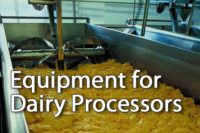Raimond: It is advisable to use a liquid-ring pump to evacuate CIP from process lines. Because [our product] can pump CIP solution containing air, it requires less fluid to charge a system. It also reduces residual water and CIP solution left in lines and vessels and decreases soiling of wash water through better evacuation of pre-rinse.
Jordan: Our mix-proof valve systems minimize CIP solution requirements because the design allows series flow of CIP solutions and therefore maximizes recovery. [A new design] is smaller and reduces cleaning solution losses considerably over other valves. We also combine our valve designs with our nanofiltration systems to treat the CIP chemicals and allow them to be reused. This results in considerable savings for the processor and reduces water usage and waste discharge, which helps processors meet their sustainability goals.
LeClair: Processors looking for minimizing water usage during CIP are just not looking for efficient pumps, but pumps that can help them maximize the reuse of their rinse waters as they get returned to the CIP system. Our pumps work off a different principle than standard liquid ring pumps that are normally found in CIP return lines. The inducer on [one of our products] allows the user to keep minimum tank volumes without harming the pump or compromising the flow. The inducer allows the lowest NPSH requirement for any standard centrifugal pump and is essentially the missing link between standard centrifugal pumps and self-priming pumps.
For duties that require a true self-priming pump, [we have a product]. The design allows for the pump to be significantly quieter than a standard LR pump, while performing the same duty. The design also allows for the pump to perform like a standard centrifugal pump once it is primed, allowing for high-efficiency operation. This saves energy during the CIP process.
Denoth: Water is very much a factor when it comes to calculating the true cost of production in processing. When selecting process valves for plant operation, it is important to utilize an option that is highly cleanable, without internal dead spaces, and that requires a minimum of CIP time (and thus water) to properly clean the valve.
Jim Carper, editor-in-chief, edited participants’ written responses to Dairy Foods’ questions.
Read comments from three additional manufacturers of pumps and vales for dairy processing. Share your own opinion and leave a comment.
|
Should you use OEM or after-market parts? 2 views |
|
After-market parts might be less expensive, but they are not always a great deal in the long run.Dairy Foods asks: What should a processor know about aftermarket parts for pumps and valves?
Yes to after-market parts. “Food processors should take advantage of after-market replacement parts when “true” cost savings are available. In addition to savings, processors need to have more than one source of supply for equal or better replacement parts in critical plant operations. “The primary consideration in evaluating after-market replacement parts is that they meet or exceed industry material specifications and standards for the application, and are manufactured in a traceable and accountable manner. Consumers have been buying after-market personal safety automobile parts for decades. Processors should seek products from manufacturers who have (at the very minimum) an ISO Quality Management System in which the parts are manufactured. “After-market food contact parts should be manufactured by a company that has successfully met the requirements of the Replacement Part Qualification Certificate Program, and holds a current 3A Replacement Parts Manufacturer Certificate. Materials and the traceability of their origins and quality are critical. After-market parts buyers can save money and buy with confidence if the material has been given a Letter of Non Objection for food contact from the FDA.” — Frank S. Panico, President, Alloy Cast Products, Kenilworth, N.J.
No to after-market parts. “Being able to copy parts does not mean you have the expertise to apply them. After-market parts are simply reverse-engineered approximations of the OEM parts. Seal kits and components are commonly duplicated; however, dimensions are often incorrect. More importantly, tolerances may be off. If a seal component is designed to be within 0.05 millimeters of a measurement, a copy with a tolerance of 0.15 millimeters may cause leaking. The ‘stack-up tolerance’ (all components together) can be off enough to cause serious seal failure. With pumps, spring and O-ring compression must be precise, as well. It is not enough to match dimensions. “The OEM has the original certifications of all of their parts and after-market parts may not be FDA approved. Additionally, using after-market parts could invalidate a product’s warranty. “Often the money saved short-term by purchasing low-cost after-market pumps are not worth the long-term problems they cause in lost production time and product loss.” — Sam Raimond, Applications Engineering Supervisor, Fristam Pumps USA, Middleton, Wis. |







